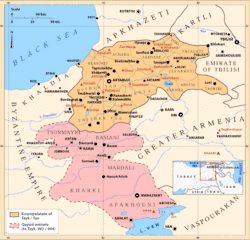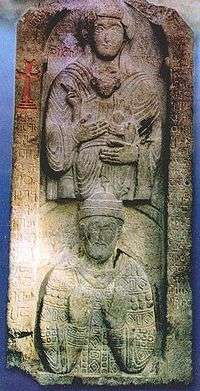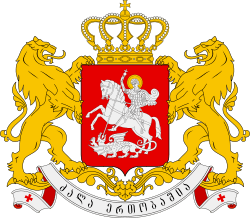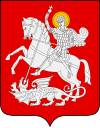Principality of Tao-Klarjeti
| Principality of Tao-Klarjeti (Kouropalatate of Iberia) ქართველთა სამეფო | |||||||||||
|---|---|---|---|---|---|---|---|---|---|---|---|
| 813–1008 | |||||||||||
 Flag | |||||||||||
 Principality of Tao-Klarjeti | |||||||||||
| Status | Kingdom | ||||||||||
| Capital |
Artanuji Bana | ||||||||||
| Common languages | Georgian | ||||||||||
| Religion | Eastern Orthodox (Georgian Orthodox Church) | ||||||||||
| King | |||||||||||
• 813-826 | Ashot I of Iberia (first) | ||||||||||
• 881-923 | Adarnase IV (first to be titled as a "King of the Georgians") | ||||||||||
• 994-1008 | Gourgen II (last) | ||||||||||
| Historical era | Early Middle Ages | ||||||||||
• Ashot I established the Kuropalatinate of Iberia | 813 | ||||||||||
• vassal of the Byzantine | 813-888 | ||||||||||
• Adarnase IV is crowned as "King of the Iberians". | 888 | ||||||||||
| 923 | |||||||||||
• Iberia is controlled by the kingdom of Abkhazia. | 912-975 | ||||||||||
| 1001 | |||||||||||
• Unification of the Georgian State | 1008 | ||||||||||
| |||||||||||
| Today part of |
| ||||||||||
Principality of Tao-Klarjeti[1] (Georgian: ტაო-კლარჯეთი), also referred to as the Iberia[1] (Georgian: ქართველთა სამეფო), was a constellation of medieval Georgian political entities, succeeding the Principality of Iberia, in what is now parts of the provinces of Erzurum, Artvin, Ardahan and Kars in north-eastern Turkey as well parts of modern southwestern Georgia.
In the 9th to 11th centuries, Tao-Klarjeti was ruled by the Bagrationi dynasty, and the region played a crucial role in the unification of all Georgian lands and principalities into a single feudal state, Kingdom of Georgia in 1008.
Geography
Tao and Klarjeti were originally only the names of the two most important provinces in kingdom of Iberia, or upper Iberia that stretched from the Iberian Gates in the south and to the Lesser Caucasus in the north. Historically, the area comprised the following provinces: West of the Arsiani Mountains were Tao, Klarjeti, Nigali, and Shavsheti, to the east lay Samtskhe, Erusheti, Javakheti, Artaani, Abotsi, Kola and Basiani. The landscape is characterised by mountains and the river-systems of the Çoruh and the Kura. Tao-Klarjeti’s geographical position between the great Empires of the East and the West, and the fact that one branch of the Silk Road ran through its territory, meant that it was subject to a constant stream of diverging influences.
History
The principalities of Tao-Klarjeti arose out of the turmoils of the Muslim conquests in the Caucasus in the 7th and 8th centuries, succeeding the early medieval kingdom of Iberia.
The new era began in Tao-Klarjeti in 813, when the last Iberian prince Ashot I of the Bagrationi dynasty moved to Klarjeti and made it a base in his struggle against the Arab occupation. Recognizing the Byzantine suzerainty, he received a title of Curopalate (Greek: κουροπαλάτης) and established the Kouropalatate of Iberia. Ashot fought the Arabs from there, gradually incorporating the surrounding lands of Tao, Kola, Abotsi, Artaani and Shavsheti, along with a few other lesser lands, from the Arab dominance. He encouraged resettlement of Georgians in these lands, and patronized monastic life initiated by the prominent Georgian ecclesiastic figure Grigol Khandzteli (c. 759–861) in Klarjeti. For a long time the region became a cultural safe-house and one of the most important religious centers of Georgia.

Ashot’s successors continued fighting for the central Georgian land, known as Kartli, contested also by the Kingdom of Abkhazia, the Arab emirs of Tbilisi and even by Kakhetian and Armenian rulers of Tashir-Dzoraget. However, internal feuds, not infrequent in the principality, were an important obstacle. A civil war following the assassination of David I (c. 876–881) brought the victory of Adarnase IV (c. 881–923) over his major rival, Nasra, David’s murderer, allowing him to be crowned as "King of the Iberians" in 888. During the reign of Adarnase’s son David II (c. 923–937) the Georgians had also to defend against the Byzantine aggression, a problem they seem to have successfully managed. However, the Bagrationi dynasty failed to maintain the integrity of their kingdom which was actually divided between the three branches of the family with the main branch retaining Tao and another controlling Klarjeti and nominally recognizing the sovereignty of the king. The Kingdom also included several other minor princedoms dependent to the princes of Tao.
In 958, Bagrat II Regueni, "the Simple" (c. 958–994) was crowned as "King of the Iberians" and inherited Northern Tao (also known as Amier-Tao), while David III (c. 961–1000/1001) received a title of Kuropalates and held Southern Tao (also known as Imier-Tao). A just ruler and a friend of the church, David allied with the Byzantine Emperor Basil II to defeat the rebel Byzantine noble Bardas Skleros (c. 976–979) and was rewarded with extensive lands, known to the contemporary Georgian sources as the "Upper Lands of Greece", that made him the most powerful ruler in the south Caucasus: his state included several former Kaysite lands consisting chiefly of lands up to the Lake Van[2]: Theodosiopolis, Phasiane, Hark, Apahunik, Mardali, Khaghto-Harich (Speri), and Chormayri.
With the strong intention to unite all Georgian lands, he adopted Prince Bagrat (the future King Bagrat III), a grandchild of Bagrat Regueni, also being an Abkhazian heir apparent. David installed him as a residing prince in Kartli (975) and later as king of Abkhazia (978), and helped Bagrat’s natural father Gurgen to be crowned as King of Kings of the Iberians on the death of Bagrat the Simple (994), thus making Bagrat a ruler of the two and heir apparent of another two Georgian states. The only setback was the 987–989 unsuccessful conflict with the Byzantine Empire that forced David to agree to cede his dominion to Emperor Basil II on his death, whose domains later would be organized into the theme of Iberia. Despite this reverse, Bagrat was able to become the first ruler of the unified Georgian kingdom (officially called: "the Kingdom of the Iberians and the Abkhazians") on his father’s death in 1008.
Bagrationi dynasty rulers of Tao-Klarjeti
Bagrationi Dynasty from Iberian Line
| King | Reign | Notes |
|---|---|---|
| 1. Ashot I | 813 – 826 | |
| 2. Bagrat I | 826 – 876 | co-rulers: Adarnase II and Guaram Mampali |
| 3. David I | 876 – 881 | |
| 4. Adarnase IV | 881 – 923 | |
| 5. David II | 923 – 937 | |
| 6. Ashot II | 937 – 954 | |
| 7. Sumbat I | 954 – 958 | |
| 8. Bagrat II | 958 – 994 | |
| 9. Gurgen | 994 – 1008 | |
| 10. Bagrat III | Unification of the Georgian State |
Bagrationi Dynasty from Tao Line
| Prince | Reign | Notes |
|---|---|---|
| 1. Gurgen I | c. 870 – 891 | |
| 2. Adarnase III | 891 – 896 | |
| 3. Ashot | 896/908 – 918 | |
| 4. Gurgen II | 918 – 941 | |
| Divided among other branches of the dynasty. |
Bagrationi Dynasty from Second Tao Line
| Prince | Reign | Notes |
|---|---|---|
| 1. Bagrat I | d. 945 | |
| 2. Adarnase V | 945 – 961 | |
| 3. Bagrat II | 961 – 966 | |
| 4. David III | 966 – 1001 | |
| 1001 | annexed to Byzantine Empire |
Bagrationi Dynasty from Klarjeti Line
| Prince | Reign | Notes |
|---|---|---|
| 1. Sumbat I Mampali, the Great | 870 – 889 | |
| 2. Bagrat I | 889 – 900 | |
| 3. David I | 900 – 943 | |
| 4. Sumbat II | 943 – 988 | |
| 5. David II | 988 – 992/993 | |
| 6. Sumbat III | 992/993 – 1011 | |
| 7. Gurgen | (d. 1012) | annexed to Kingdom of Georgia |
See also
References
Sources
- Stephen of Taron: Histoire Universelle par Étienne Asolik de Taron, transl. F. Macler, 2e partie, livre III (888-1004), Paris 1917
- Constantine Porphyrogenitus: De Administrando Imperio, ed. G. Moravcsik and R.J.H. Jenkins, Dumbarton Oaks 1967
- Aristakes Lastivert: Récit des malheurs de la nation arménienne, transl. M. Canard and H. Berberian, Brussels 1973
- Thurn, Hans, ed. (1973). Ioannis Scylitzae Synopsis historiarum. Berlin-New York: De Gruyter.
- Elishe: History of Vardan and the Armenian War, transl. R.W. Thomson, Cambridge, Mass. 1982
- The Life of Kartli: Das Leben Kartlis. Eine Chronik aus Georgien. 300-1200, ed. G. Pätsch, Leipzig 1985
- Life of John and Euthymius: B. Martin-Hisard, “La Vie de Jean et Euthyme: le statut du monastère des Ibères sur l'Athos”, Revue des Études Byzantines 49 (1991), 67-142
- Yahyā ibn Sa‘īd al-Antākī: “Histoire de Yahya-Ibn-Sa‘ïd d’Antioche”, ed. and transl. I. Kratchkovsky and A. Vasiliev, Patrologia Orientalis 18 (1924), 700-833
- “Histoire de Yahya-Ibn-Sa‘ïd d’Antioche”, ed. and transl. I. Kratchkovsky and A. Vasiliev, Patrologia Orientalis 23 (1932), 347-520
- “Histoire de Yahyā ibn Sa‘īd d’Antioche”, ed. I. Kratchkovsky, transl. F. Micheau and G. Troupeau, Patrologia Orientalis 47 (1997), 373-559
- Giorgi Merchule: Georgi Mertschule. Das Leben des Grigol von Chandsta, transl. S. Sardshweladse and H. Fähnrich, Jena 2000
- Yovhannes Drasxanakertci: Histoire d'Arménie, transl. P. Boisson-Chenorhokian, Leuven 2004
- Bruno Baumgartner, Studien zur historischen Geographie von Tao-Klarjeti, PhD-Dissertation, 2 Volumes, Vienna 1996 ("Studies on the historical Geography of Tao-Klarjeti", in German)
External links
| Wikimedia Commons has media related to Tao-Klarjeti. |

